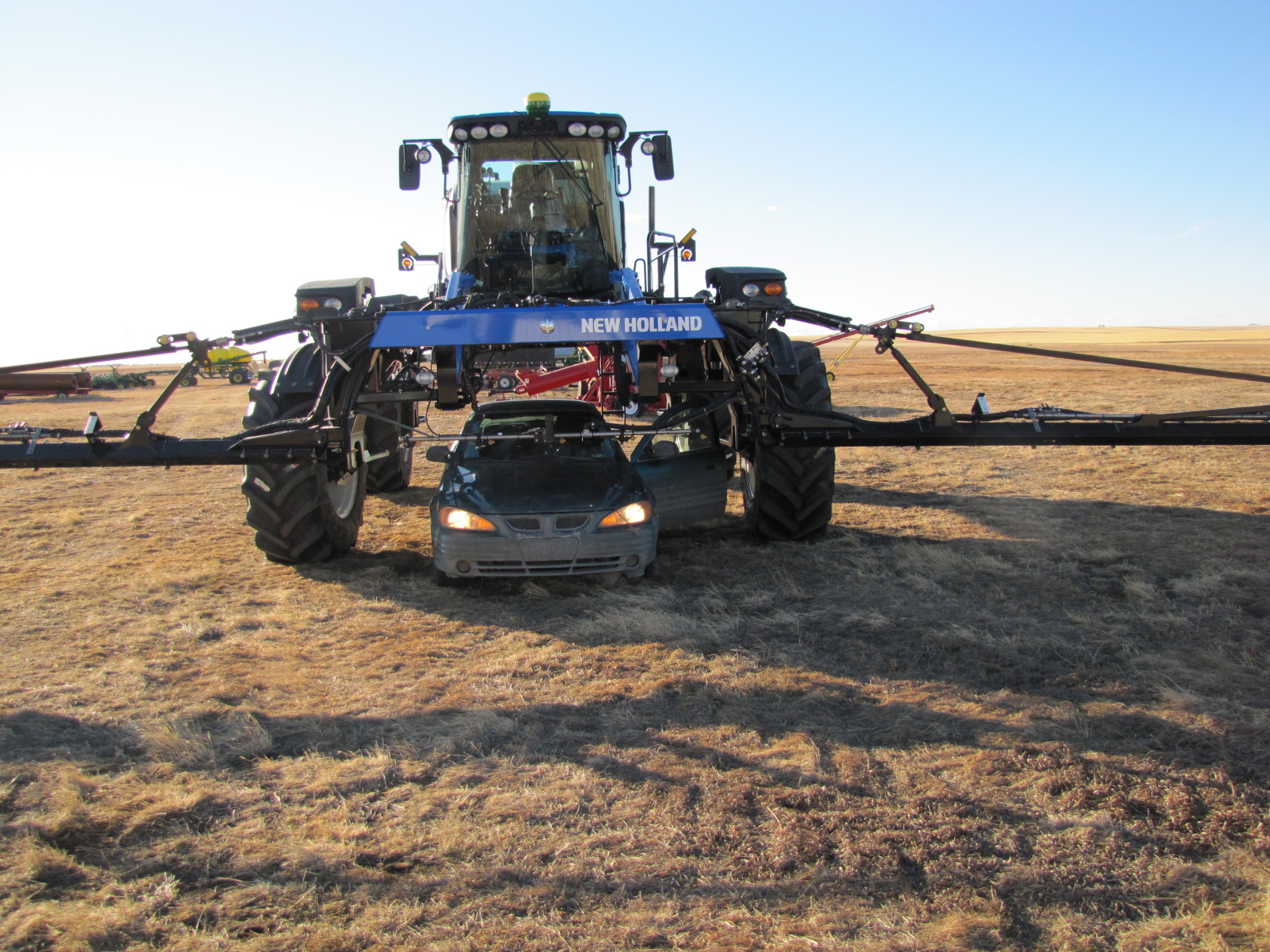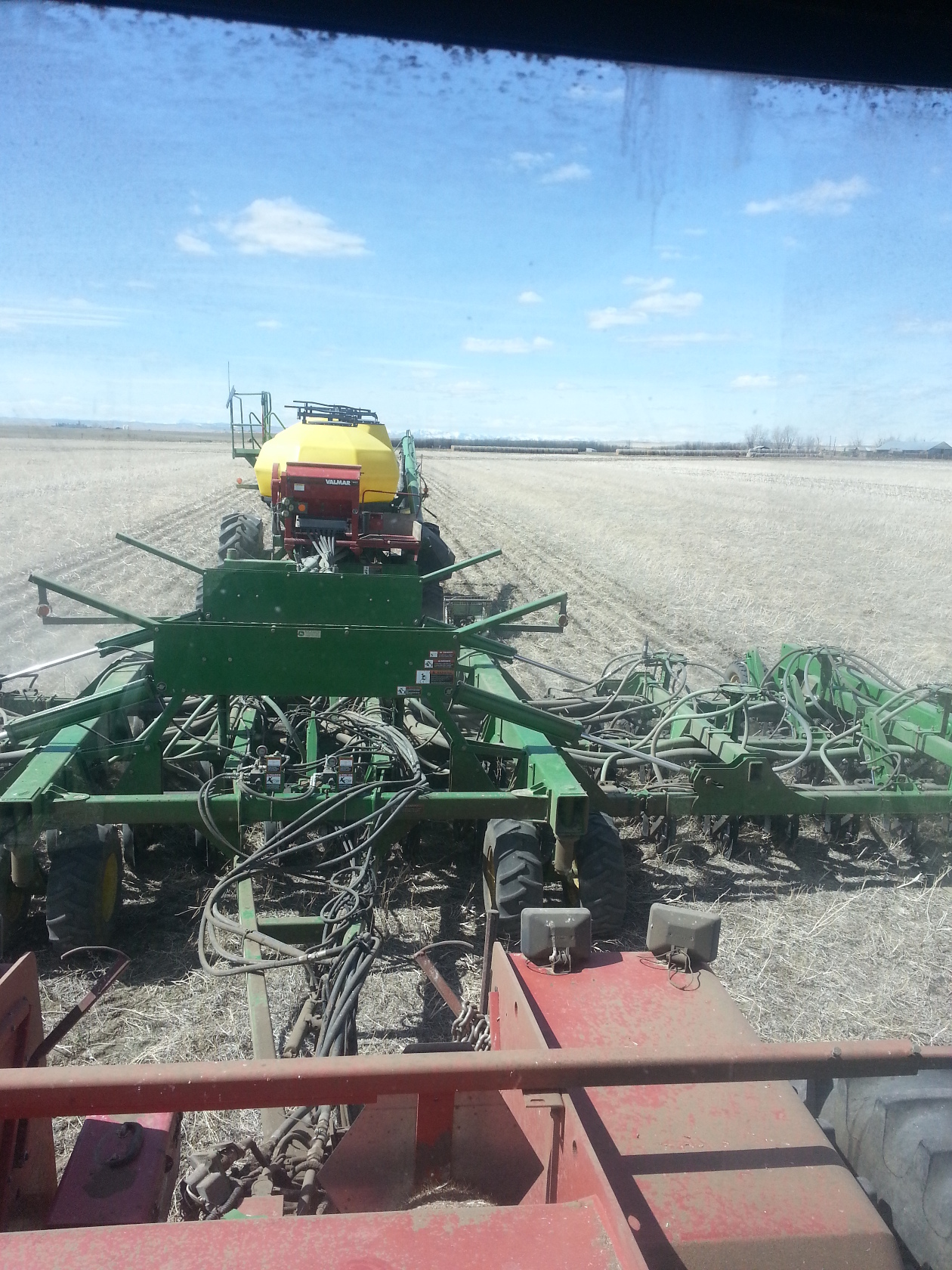Did You Know?
Just because you see our sprayer in the field does not mean it is spraying pesticides. We use our sprayer to apply many products from very small seeds, to micro nutrients to help the crop grow.

Our Sprayer is fully equipped with state of the art weather monitoring systems allowing our operators to track weather data in real time allowing us to make in cab decisions about potential off target movement of crop protection products.
Vital to Soil Health
We use many various inputs (fertilizers,chemicals, seed, biological) in crop production everything from fertilizers to help offset the nutrients we are exporting from the field in the food we produce, to biological additives designed to help the microbes in the soil grow and thrive.
We use crop inputs for many reasons, the most important one is to replace the nutrients we have removed from the soil. Soil is a living ecosystem and it needs to be fed, and given the things it needs to thrive. Some nutrients can be provided through relationships between plants and soil organisms as is the case with nitrogen, which can be supplemented by growing legumes. Nutrients such as phosphate are only provided naturally in small amounts and need to be replaced through the use of fertilizers in order to keep production at high levels without harming the soil.
Pesticides are also vital to our success as they are one of the few ways we can control weeds without having to resort very detrimental tillage. The dirty 30's were caused by tillage interfering with the soils natural state. In a native state, nature does not till and soil ecosystems are not adapted to tillage. By using herbicides to replace tillage we are able to more closely simulate a soils natural state, improving yields while improving soil health.
Pesticides while a vital part of our farming system, are not a particularly well liked part of our system. We are constantly doing our best to reduce our reliance on herbicides, very rarely use fungicides and almost never use insecticides. As by using proper crop rotation we can dramatically reduce the need for fungicide and insecticide while at the same time lowering the required amount of herbicides.
Using Research to Determine What is Truly Needed.
We are always doing large scale on farm research to determine if a particular product is required and at what rate. Over the years we have accumulated vast amounts of data and have pin pointed what is truly required on our farm under our soils rather than having to rely on outside sometimes biased sources to tell us what is required on the land. Admittedly this can be a complex process but we have had lots of experience with on farm research, if you wish to know more contact us.

Seed Treatment
Insecticides, Fungicides, Seed Treatment and Neonicotinoids
Our entire production philosophy is based on using a minimal amount of Insecticides, Fungicides, and herbicides, while still maintaining profitable yields and building soil.
A small portion of our crop production program involves insecticides. If we do use insecticides we do so with the realization that there are two kinds of insects
Beneficial insects: Insects that help the crop be it with pollination or predation of insect pests. Some insects are not directly beneficial to plant health but provide valuable diversity and at times food for beneficial insects, the vast majority of insects are beneficial. These include spiders (not an insect) ladybugs, all kinds of beetles, and bees.
Non-beneficials or pests: small numbers these insects is not a problem for crops and they are a valuable part of the ecosystem, these can cause severe crop damage if they reach high enough levels. But most years a healthy population of beneficials and good crop rotation keeps their numbers in check.
The biggest insect pests we deal with are lygus bugs, flea beetles, and cabbage seedpod weevil in canola.
Grasshoppers are also a problem in dryer years.
Insecticidal Seed Treatments
With national press and environmental groups raising the profile of seed treatment in recent years. We thought it would be a good idea to explain our approach on the topic.
There are two primary types of seed treatments, each with its own purpose.
- Fungicidal seed treatment, for the prevention of root disease.
- Insecticidal seed treatment, for prevention of insect pests.
Insecticidal seed treatment contains neonicotinoids; some claim neonicotinoids are killing beneficial insects. We have heard equally smart and articulate arguments from people who claim neonicotinoids are not a problem and from individuals who think they are.
We at Lamb Farms do not claim to know every aspect of the disputed science behind this issue, we do know that blanket application of any kind of insecticide is normally a very bad idea, as generally insecticides affect both beneficial insects and pests. We generally believe that insecticides (of all types) should only be used under the following conditions.
- Problem insect (pest) must be present. We do not apply any insecticides unless the insect is confirmed in that particular field. At higher (typically 3X) than what is normally considered an industry standard threshold.
- Foliar applications do not happen unless insect is three times over threshold. We are willing to take a small yield loss in order to preserve our beneficial insects.
- Seed placed insecticides are rarely used. The only case when they are used is on canola, this is from sheer practicality as it is virtually impossible to buy canola seed that had not been treated. To help minimize the impact of this we have moved to planting canola with a row crop planter so we can seed canola at far lower than industry standard rates which lowers the amount of insecticide we have to use.
- Just in case or insurance applications (applications because there may be an insect) are not used. We also do not apply simply because we are going across the field anyways, insecticide is cheap, and there may be a problem insect present. We believe this is very detrimental as it kills both the beneficials insects and pests indiscriminately
Using these methods we have practically eliminated insecticides from our system . Neonicitanoids are typically only used on canola seed for reasons already stated.
Fertilizer
We also use a fair amount of fertilizer, and feel that it is vital to our system. There are 3 types of Macro nutrients that we are especially concerned about.
-
Nitrogen: Important for most metabolic processes in plants especially chlorophyll production, nitrogen is often the most limiting nutrient in our growing conditions. Nitrogen can be “fixed” by some plants mainly legumes (Peas, Faba beans, Lentils, Alfalfa, Clovers, and Chickpeas in our system). These plants form a symbiotic relationship with living bacteria rhizobia. The bacteria converts nitrogen from the atmosphere into a form that plants can use, in exchange the plant provides sugars (energy) for the bacteria to survive and reproduce.
Unfortunately we cannot only grow legumes as there are some crop rotation constraints. Intercropping is allowing us to get more and more Nitrogen from legumes on our farm all the time.
-
Phosphate: Is essential for root growth and the plants natural defenses against weather extremes and pests. Phosphate is especially important in the seedling stage. We need some phosphate for all of the crops we grow. Because we have cattle on much of our land many of our long term cattle fields to require very little additional phosphate.
-
Potassium: Important for water uptake and other metabolic processes, we are blessed with high amounts of potassium in our soils. We have grown crops on the land here for over 100 years the levels of potassium are slowly decreasing, chances are we will have to start adding this as fertilizer within 30 years
Fertilizer and fertility planning is a complex process and members of Lamb Farms have taken entire courses dedicated to figuring out how to apply just the correct amount of fertilizer and how to minimize the environmental risks associated with applying fertilizer incorrectly.
The first step is to collect soil samples and send them in for laboratory analysis, from there we can determine the rest of what the industry calls the 4 R’s
- Right fertilizer source at the
- Right rate, at the
- Right time and in the
- Right place
To learn more about the 4 R’s please see http://www.nutrientstewardship.com/4rs/.
Fertilizer is expensive and fertilizer costs make up a very large percentage of our total cost to grow a crop. With this always in mind we do our best to never over fertilize as applying any fertilizer in the Wrong Amount, at the Wrong Time, or in the Wrong Place directly hurts our farm profitability.
Fertilizer Application
In order to apply fertilizer according the the 4 R principles we have given ourselves as many options as possible to help with this. We can apply fertilizer with the following methods.
- With the Seeding Equipment: either during or before the actual seeding operation: This is the standard in Western Canada. We have the ability to apply all or most of what our crop needs with our seeding equipment. This method has risks as fertilizer is often applied before the crop has even started growing and that makes it very hard to predict how much fertilizer the crop will need to reach the potential that the rainfall and other environmental factors will allow it to reach. This approach often leads to over fertilization.
- With in Crop Broadcast Equipment: Either with the sprayer if using liquid fertilizers, or with our state-of-the-art granular fertilizer spreader. This equipment is often used to apply fertility to the crops just as they need it further on in the growing season as we have a better idea of how much the crop actually needs. In a dry year these tools will hardly be used, keeping the fertilizer in the bin where it should be. In years with better growing conditions we will be able to make sure the crops have enough nutrients to reach their full potential by applying nutrients precisely in crop. We do this using Tramlines and Precision AG. Both the sprayer and the spreader are GPS controlled and have the ability to automatically shut off sections (parts of the boom and spread pattern) to ensure areas that we have already applied product on (such as turns) do not double up the amount of fertilizer applied.
These machines also have the ability using GPS and some pre-programming to apply a variable amount of product in specific areas of the field. This means that we can apply exactly the right amount of fertilizer for every area of the field. Often instead of applying one amount of fertilizer throughout an entire large field we will make 6 or 7 smaller fields out of the big field using precision agriculture.
Lamb Farms typically uses a hybrid approach. We apply a starter amount (30-50% of total estimated needs) of fertilizer with our seeding equipment and then apply the balance in-crop as we know more about the crop conditions and long term forecasts.